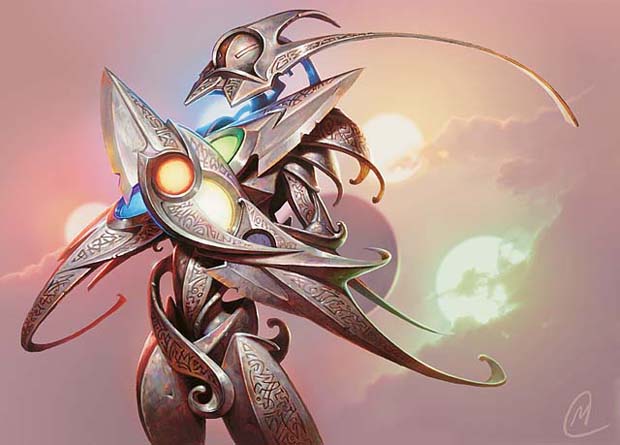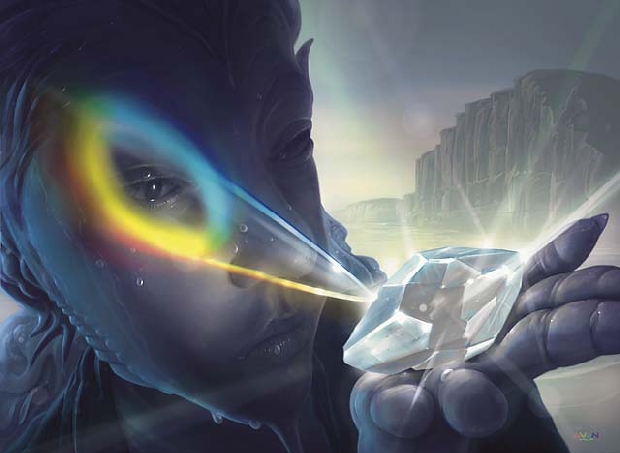The Nightmare Before
Welcome back, card-crafters! Last week, we discussed the non-white sector (I'm going to try out this term for the four-color groupings for this article, instead of "tier," just to see how it feels) both creatively and mechanically. This week, before we move any further with the sectors, we'll take a step back and focus on another important part of Magic: The Gathering set design: The design skeleton.
What is the design skeleton? Well, Mark Rosewater explains it best (and introduced it to the world outside of R&D) in his article Nuts & Bolts: Design Skeleton. But, first, if you haven't already, you should read the first part of his Nuts & Bolts series - Nuts & Bolts: Card Codes . The latest part of this annual series is Nuts and Bolts: Filling in the Design Skeleton.
These three articles are ones I highly recommend for aiding in the process of designing your own Magic set. The Card Codes article is for understanding the strange letters-and-numbers sequences that are used in a design skeleton. The Design Skeleton article tells you about what it is. Lastly, the Filling in the Design Skeleton tells you how to properly use that skeleton.
With that out of the way, I'll link you to our set's design skeleton right now, so you can reference the document while you follow along with the article (or if you're already savvy in Magic design, you'll be getting right to the point). Also, the design skeleton is a little bit ahead of what we're talking about today (the commons), so don't be alarmed when you reach the end of the article and there is still more content on the design left unreferenced. Here's the skeleton, hosted on Google Docs:
Anti-Magic Marrow
So, that brings us to our set. Our set is a typical large expansion, like the ones that usually appear in the fall, like the Scars of Mirrodin set. In modern Magic design, a large set contains 249 cards. However, twenty of those cards are usually basic land -- four different pieces of art per basic land. That will be true for our set, which leaves 229 cards.
Usually, each set balances the number of cards per color. For example, look at the commons of the about-to-be-released set, New Phyrexia. There are ten commons per color. Even the Souleater cycle makes sure to have one of each color represented in that type of design. However, this four-color set we're working on is special since we're not featuring all five sectors in it. This set is the large set of a block, and the block's first two sets will split up the five different four-color sectors with three being introduced in the first set and two in the second. The layout of the sectors across the sets is reminiscent of the Ravnica block where ten two-color guilds were spread out across the three sets of the block (four in the large set, then three in each of the subsequent small sets).
(Our block will have a third set, too, but it's more of a culmination of what happens when these isolated sectors break their geographical barriers and meet up. It's the climax! This is like Shards of Alara's block's Conflux and Alara Reborn sets. But enough of the later sets, let's get into the nitty-gritty of this large set!)
Now, this first large set will have these three sectors:
The non-white sector, which is blue, black, red, and green (UBRG).
The non-black sector, which is red, green, white, and blue (RGWU).
The non-red sector, which is green, white, blue and black (GWUB).
The non-black sector, which is red, green, white, and blue (RGWU).
The non-red sector, which is green, white, blue and black (GWUB).

The color ratios across these three sectors are not balanced. Every sector has access to blue and green. If we kept an equal balance across all the cards in terms of color ratios, blue and green would become valuable commodities (assuming we want to encourage players to play these specific four-color groupings, which we do). In draft, there might be a phenomenon where blue and green cards get snatched up early and quickly. And if you're going to try to achieve four colors, you're going to need blue and green represented. To restore the balance to the force, the ratios in the set will reflect the ratios in these sectors, which means: 1/6 white, 1/4 blue, 1/6 black, 1/6 red, 1/4 green. To put it another way, for every twelve monocolored cards, it'd be: two white, three blue, two black, two red, three green. This way, there will be plenty of blue and green cards for everybody when drafting the three different sectors.
NOTE: In modern Magic design, designing your set with Limited (this includes drafting and sealed pack) in mind is essential since they're hugely popular ways of playing Magic. It's the format of prereleases and of most Friday Night Magic events for goodness' sake! You get my point. It's important. And this importance applies when you're designing commons and uncommons, as well. We'll get to those in the future when we're actually designing cards.
Skelingtons
So, now we know how our color ratios are going to go. What next? Well, we take a look at how we're having a heavy use of multicolored cards. We're also using hybrid as a tool to get more colors onto a card with half the mana symbols. That means there are several possibilities (the following are the terms I'm giving these kinds of cards, not official Magic R&D ones):
Traditional hybrid: Two colors and its colored mana costs are made up completely of hybrid mana symbols
Two-Color Gold: Two colors and its colored mana costs consist only of the traditional colored mana symbols
Three-Color Gold-Hybrid: Three colors and its colored mana costs, in this set, will be using one traditional colored mana symbol and one hybrid mana symbol
Four-Color Double-Hybrid: Four colors and its colored mana costs are made up of only hybrid mana symbols, except with two different kinds. For example, a white/black hybrid mana symbol, and a blue/red mana symbol.
Four-Color Gold-Hybrid: Four colors and its colored mana costs are, in this set, two traditional mana symbols matching the two center colors of a four-color grouping and a hybrid mana symbol for the other two colors.
Four-Color Gold: Four colors and its colored mana costs are made up of only tradtional colored mana symbols.
We'll be using these different types of cards. Some are only fit to be as a part of a cycle, like the four-colored cards. That leads to another special part of this set: since there's three sectors in this set, representing a cycle involving four colors would mean there would, instead of the traditional five, be only three cards as a part of that cycle. I see this as a good thing since it lowers the amount of color density in the set and leaves room for more less-colored cards!
First off, let's construct the commons. The ones that we know that we're going to get out of the way are, as in Ravnica and Shards of Alara, we'll use a cycle of artifacts that fix mana geared toward a certain sector.
3 Artifact Mana-Fixers
We also will do the same with lands in common for the same reasons as above:
3 Land Mana-Fixers

As Mark Rosewater often says, if your theme isn't at common, it isn't your theme. Since our theme is four colors, we'll need a cycle of common four-color cards. Just as Shards of Alara did with its cycle of three-color cards, like Windwright Mage, we'll include a cycle of four-color gold cards.
3 Four-Color Gold
We can also flip what Mark Rosewater said on its head and apply it the other direction. We don't want players who open up booster packs of this set to see that this set is a three-color set. But, the three-color gold-hybrid cards, as they debuted before in the Alara Reborn set in the form of Marisi's Twinclaws, are three colors. If we don't put this at common, that means we're saying that this set is NOT a three-color set. We'll put it at uncommon, though. Giving wedge Commander decks some more firepower while appearing in smaller numbers to lessen the chance somebody'll get confused this is Shards of Alara 2 or something.
Though, the four-color gold-hybrid cards are O.K. We'll include one for each sector for those.
3 Four-Color Gold-Hybrid
However, we can't keep everything four-color, so we'll make use of two-colors and monocolored cards at common. Besides, not counting the few card cycles of four colored cards, this creates an interesting tension where most of your cards are one or two colored. It makes the player work to get three cards that fulfill their quota of four colors. Three cards to get? Reminds me of metalcraft's magic number threshold of three. Since this is concerning color, it should be at least the same difficulty, if not easier, to get to four colors (through three cards). And going through the hard work of having two two-colored cards that each have different colors from the other to achieve four colors seems like a great reward.

Drudgin'
That brings us to the "rest of the commons" to tackle. With monocolored, I took a look at Shards of Alara commons to get an idea of how many cards of each color there should be along with how much of the set should be monocolored. According to Zendikar, there's 18 cards per color. The "norm!" In Shards of Alara, however, there are 15 cards per (mono)color. Though, that's also with ten cards of mana fixing (five card cycle of artifact fixing, and five card cycle of land fixing. At common, I mean).
So, I'll include another cycle of mana-fixing. Not sure what kind of cards they'll be. Yet.
3 MORE Mana-Fixers
And, for good measure, one of the remaining artifacts will be mana-fixing, like what Prophetic Prism did in Rise of the Eldrazi.

Great. And nearly half the set in Shards of Alara set was monocolored. So, if we multiply the ratios (in terms of dozens) among the colors by four, we get 48 cards. That's close to half.
48 Monocolored
Then hybrid happens, and because of how hybrid intermingles two colors on one card, to keep the ratios balanced, after doing the math, we need 18 hybrid cards (I should've intuited right from the get-go getting double the colors for the same price means half the cards needed. So, 6 + 12 = 18. Gotta maintain balance of the force, brah.
18 Traditional Hybrid
Since two-color gold cards are the same colors as traditional hybrids, we'll simply copy the same numbers:
18 Two-Color Gold
And that should leave room for four artifacts. Remember, one of them can we can use to make sure it fixes mana or something (in a broad usage kind of deal) to further ensure that four colors is easier to draft. Whatever the case may be for each of these artifacts, there's four of them:
4 Artifacts
Dia de los Muertos

And I'll leave it at that for now. Join me next time when I discuss and fill in further the design skeleton! We'll get to the other sectors eventually, but for now, we're sketching out things.
Seeyanaras, designers!
Cheers,
Brad



No comments:
Post a Comment